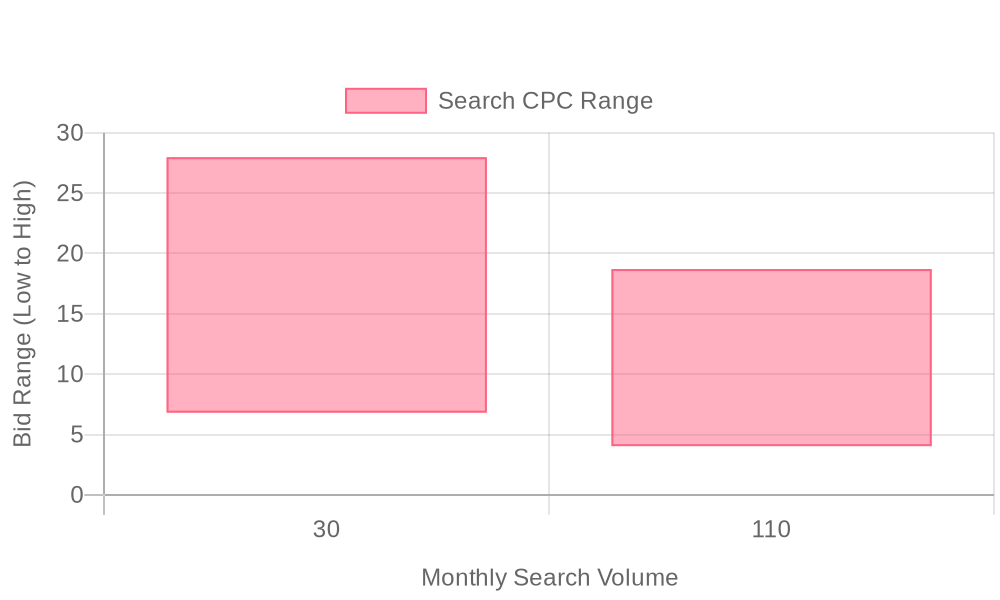
Supercharge your lead generation with a FREE Google Ads audit - no strings attached! See how you can generate more and higher quality leads
Get My Free Google Ads AuditFree consultation

No commitment
Supercharge your lead generation with a FREE LinkedIn Ads audit - no strings attached! See how you can generate more and higher quality leads
Get My Free Google Ads AuditFree consultation

No commitment
Supercharge your lead generation with a FREE Meta Ads audit - no strings attached! See how you can generate more and higher quality leads
Get My Free Google Ads AuditGet My Free LinkedIn Ads AuditGet My Free Meta Ads AuditFree consultation

No commitment
Supercharge your lead generation with a FREE Google Ads audit - no strings attached! See how you can generate more and higher quality leads
Get My Free Google Ads AuditFree consultation

No commitment
In the ever-evolving marketing landscape of communication technology companies, capturing high-intent leads is both a priority and a challenge. Missed opportunities often occur because high-value prospects are not tracked in CRM systems. This gap underscores the importance of precision targeting in Google Ads, which allows firms to intercept decision-makers exactly when they're searching for solutions. This article explores how Google Ads for Communication Technology Companies can effectively bridge online tactics with offline sales strategies, providing a comprehensive setup guide for revenue teams.

Digital advertising stands as a core driver for lead generation in the communication technology sector. Companies in this space rely on highly targeted, data-driven approaches to reach business buyers who research and compare technical solutions online. For a deeper dive into implementing Google Ads in this industry, see strategies to leverage Google Ads for managed IT services, which shares actionable tactics for attracting and converting technical buyers.
Google Ads for Communication Technology Companies delivers unique advantages by enabling precise segmentation, real-time optimization, and measurable campaign ROI. Revenue teams can connect with enterprise IT decision-makers and technical influencers at critical moments in their buying journey, ensuring every dollar invested supports pipeline growth. To further understand how marketing can drive measurable results, explore our guide to measuring marketing’s influence on the sales pipeline.
Success in PPC for communication tech starts with targeted keyword research and advanced audience building. Rather than relying solely on broad or generic terms, prioritize high-intent, solution-specific phrases like “enterprise VoIP integration,” “5G private network providers,” or “cloud PBX for midsize business.” These keywords should map to your core offerings and the technical pain points your audience faces. For tips on mapping keywords to buyer needs, see our essential guide to account-based marketing.
Audience segmentation must be equally refined. Use in-market and custom intent audiences to identify buyers actively researching communication infrastructure or unified communications platforms. Modern platforms allow marketers to pinpoint which companies and people are visiting your website, even if they don't fill out a form. This actionable insight lets you prioritize spend on accounts demonstrating genuine interest—enabling you to adjust targeting and bids in real time as intent signals shift.

Landing page optimization is as critical as ad targeting in the communication technology industry. Each campaign should drive traffic to a page designed specifically for the targeted keyword or audience segment. For example, a campaign aimed at “SD-WAN solutions” should land prospects on a page with technical documentation, integration workflows, and an interactive ROI calculator tailored to network engineers and IT managers. To see how top enterprises drive campaign success, review how top enterprises succeed with Google Ads.
Compelling ad creatives must balance technical credibility and business value. Highlight key differentiators such as security certifications, uptime guarantees, or seamless CRM integrations. Use dynamic content to personalize messaging based on known account data or user behavior. This level of personalization ensures higher engagement and drives up conversion rates, especially when paired with real-time updates to landing page content as visitors move through the funnel.
Campaign optimization is an ongoing process for communication technology marketing. Marketers should monitor performance metrics such as click-through rates, conversion rates, and cost per lead daily, using insights to refine bids, adjust budgets, and refresh ad creative. A unified data approach allows teams to connect Google Ads performance with CRM outcomes—enriching lead profiles, updating account scores, and tracking pipeline impact through both online and offline conversion events. For emerging best practices, see Google Ads best practices in 2025.
Integrating Google Ads with your CRM and sales automation tools is a game-changer. Real-time syncing ensures that every high-intent lead and account engagement is immediately actionable for follow-up and nurture. As audience lists and lead scores update dynamically, campaigns can retarget or suppress accounts based on their latest funnel stage, maximizing efficiency and ROI across your entire online marketing strategy. To streamline this process, use Sona Destinations to sync high-quality audience data into your GTM tools for timely follow-up.
Communication technology companies achieve superior results when their Google Ads targeting is powered by enriched CRM data and real-time intent intelligence. Automated account enrichment fills in missing firmographic and technographic details, while continuous monitoring of in-market behaviors updates lead and account scoring models. For advanced strategies on B2B targeting, consult this guide to B2B targeting for Google Search Ads.
With advanced integration, marketing and sales teams can push updated audience segments, intent-driven lead lists, and account scores directly into Google Ads, Salesforce, HubSpot, and other platforms. This seamless data flow empowers precise targeting, personalized engagement, and advanced conversion tracking—delivering a measurable boost in advertising ROI and lead generation effectiveness for communication technology companies. To start leveraging real-time audience segmentation and dynamic syncing, get started for free with Sona.
Communication technology companies operate in a high-stakes environment where timing and precision shape every deal. Digital advertising through Google Ads ensures that plant managers and procurement leaders discover solutions at the exact moment they are searching, meeting demand with immediate, relevant offers. This level of targeting keeps high-intent leads engaged and prevents missed opportunities due to delayed follow-up, as detailed in how B2B tech companies can use Google Ads campaigns.
The ability to react instantly to demand surges—such as network outages or urgent infrastructure requests—sets successful providers apart. With Google Ads, communication technology brands can launch targeted campaigns within minutes, efficiently directing resources to areas experiencing service disruptions or increased inquiry volumes. This agility not only supports customer needs but also reinforces a company’s reputation for responsiveness, a topic explored further in our collection of actionable marketing playbooks.
Expanding into new regions often requires more than a traditional sales approach. Online marketing strategies like Google Ads open doors to emerging markets, allowing communication technology providers to reach decision-makers in untapped territories. With integrated analytics, teams gain visibility from the initial click through to contract close, enabling precise measurement and optimization of every campaign. Platforms that unify these data points further accelerate the process, enabling marketers to identify high-value visitors and dynamically adjust audiences as prospects progress through the funnel. To experience these capabilities, get started for free with Sona.

Growth in communication technology advertising starts by identifying and capturing new market segments before competitors do. Vertical keyword targeting is a powerful lever: targeting terms specific to sectors like UCaaS for healthcare, SD-WAN for finance, or 5G infrastructure for smart cities allows campaigns to reach buyers with urgent, specialized needs. This granular approach minimizes wasted spend and produces higher lead quality, especially when paired with robust intent data and ongoing keyword refinement.
Performing a competitor gap analysis exposes segments where traditional static audience lists have left opportunities untapped. In the communication technology space, audience needs evolve quickly as organizations adopt new platforms or prioritize different technologies. Maintaining dynamic audience lists—constantly updated as leads progress through research, evaluation, and purchase stages—ensures ad spend always follows the buyers with the highest propensity to convert. With advanced visitor identification, marketers can pinpoint which companies are engaging with key assets, then tailor offers or shift budgets in real time based on in-market signals.
Industry-specific ad placements can extend reach by serving ads directly on trade association sites, technology review platforms, and sector-focused news outlets. These placements place solutions in the context of buyers’ daily workflows, driving higher engagement and recall compared to generic placements. For B2B tech companies, Google Ads campaigns can help increase brand visibility and generate qualified leads. As visitor intent shifts, content retargeting becomes critical: targeting those who downloaded a technical whitepaper with subsequent educational video ads, or nudging those who watched a demo to book a sales call, maximizes engagement at every touchpoint. Using real-time funnel data, marketers can dynamically update retargeting audiences and synchronize them with existing CRM or sales tools, ensuring that every ad dollar supports pipeline growth and measurable advertising ROI. To see how you can activate these strategies, get started for free with Sona.

Audience segmentation is essential for communication technology companies aiming to maximize advertising ROI and accelerate revenue generation. The sector encompasses diverse buying groups, including service providers, enterprise IT leaders, and specialized R&D departments, each with unique pain points and solution requirements. Effective segmentation begins by clearly defining core groups: for instance, targeting network infrastructure service providers versus R&D teams seeking emerging protocols or compliance-driven upgrades. For more on building actionable segments, explore real-time audience insights that empower hyper-personalized outreach.
Layering intent signals onto these segments creates a much richer targeting strategy. Marketers who overlay real-time behaviors—such as researching system upgrades, evaluating new collaboration platforms, or responding to regulatory changes—can dynamically adjust messaging and offers. This level of intent-based segmentation ensures ads are consistently aligned with immediate industry needs, allowing teams to shift budgets toward high-converting audiences as their priorities evolve. When visitor identification and audience scoring are managed with unified data, marketers can pinpoint not only which organizations are engaging, but also when decision-makers reach key buying stages.
Customizing ad creative and budget allocations for each segment ensures focus remains on high-value prospects. By using ICP (Ideal Customer Profile) scoring, teams can prioritize enterprise buyers with urgent expansion projects or those signaling readiness for large-scale deployments. Dynamic audience management further supports this by updating segments in real-time as buyers move through consideration, demo requests, or RFP submissions. When CRM and ad platforms are synced, enriched audiences and opportunity data flow seamlessly into Google Ads, enabling highly personalized retargeting and accurate conversion tracking. This unified approach allows communication technology companies to deliver relevant messaging at every stage, quantify true advertising impact, and scale digital marketing strategies with confidence. To see how you can harness segmentation and intent data, get started for free with Sona.

| Industry | Keyword | Monthly Search Volume | Competition Level | Low Bid | High Bid |
| Communication Technology Companies | communication technology companies | 30 | LOW | 6.81 | 27.98 |
| Communication Technology Companies | sinch inteliquent | 110 | LOW | 4.04 | 18.71 |
Effective keyword strategy in Google Ads for Communication Technology Companies begins with a detailed analysis of competition levels and cost-per-click (CPC) for the sector’s most relevant terms. In communication tech, high-intent keywords such as “enterprise VoIP solutions,” “UCaaS platform demo,” and “5G network equipment pricing” often command steep CPCs, reflecting both intense competition and strong purchase intent. Prioritizing these terms ensures budget is allocated where it can drive qualified pipeline growth, especially for campaigns focused on the bottom of the funnel. For deeper insights into how B2B tech companies can increase brand visibility and generate qualified leads with Google Ads campaigns, review this comprehensive overview.
To maximize ROI, mix high-volume industry staples with carefully selected low-competition, long-tail keywords. For example, pairing “cloud PBX integration for healthcare” and “secure SD-WAN for banks” with broader terms like “business phone system” captures both niche demand and broader market interest. This layered approach helps capture leads at different buying stages and balances immediate wins with long-term audience building. By leveraging real-time audience insights and intent signals, revenue teams can shift budgets fluidly toward high-converting accounts as new trends emerge.
With evolving buyer journeys in communication technology marketing, keeping keyword lists relevant and up-to-date is essential. Instead of manually managing static keyword lists, modern PPC for communication tech platforms update audiences dynamically as companies move through the funnel or show new intent signals. This ensures that ad spend consistently targets companies most likely to convert, while outdated or irrelevant terms are deprioritized. When marketers unify CRM, web, and ad data, they can pinpoint which search themes drive actual pipeline, enabling advanced conversion tracking and accurate ROI measurement across both online and offline activities. As a result, campaign optimization becomes continuous and responsive, aligning with the fast pace of communication technology innovation.
Effective Google Ads for Communication Technology Companies begins with meticulous keyword research tailored to specific service offerings and geographic markets. Segmenting keywords by solution—such as VoIP implementation, unified communications, or managed network services—ensures each ad group aligns with real buying intent. Adding geographic qualifiers, like “VoIP providers in Dallas” or “fiber optic installation NYC,” narrows targeting to the most relevant local or regional buyers.
Access to unified first- and third-party data fundamentally improves keyword prioritization. Marketers equipped with detailed visitor identification can pinpoint which companies and industries are searching for high-value keywords, allowing them to adjust bids and build negative keyword lists to eliminate wasted spend. This granular approach moves beyond guesswork, letting B2B revenue teams focus on commercial intent and optimize for local demand pockets. For more insight into how B2B tech companies can increase brand visibility and generate qualified leads, see this guide to Google Ads campaigns for B2B tech.
Crafting ad copy for communication technology audiences requires more than feature lists. Ads must speak directly to pain points like connectivity downtime, security compliance, scalability, and integration challenges. Headlines that name specific problems—such as “Eliminate Network Downtime for Distributed Teams” or “Secure Cloud Calling with Instant Compliance”—capture attention and differentiate solutions.
Dynamic audience enrichment enables marketers to personalize messaging based on live intent signals. As leads show interest in advanced services like SD-WAN or enterprise VoIP, ad copy can be dynamically updated to reflect those interests, boosting engagement and click-through rates. Teams that leverage real-time behavioral data craft highly relevant, conversion-focused messaging that resonates with both IT and business decision-makers. Discover strategies for leveraging Google Ads for managed IT services to further refine your approach.
Every communication technology ad group deserves a dedicated landing page matched to the searcher’s intent and technical requirements. For example, an ad for “cloud PBX migration” should lead to a page detailing migration benefits, technical steps, and ROI calculators—never a generic homepage. Consistent messaging, clear CTAs, and fast-loading mobile experiences are critical for converting high-value B2B leads.
Integrating visitor-level insights into landing pages further personalizes the user journey. When enriched company data or account segments are synced in real time, landing pages can dynamically display relevant case studies, compliance credentials, or industry-specific proof points. This tailored approach increases qualified conversions, shortens sales cycles, and generates higher advertising ROI for communication technology marketing teams. To find top agencies for expert Google Ads management, explore this Google Ads agency directory.
Continuous campaign optimization is essential in the competitive realm of PPC for communication tech. Smart bidding strategies—such as Target CPA or ROAS—automatically adjust to real-time conversion data, prioritizing ad spend on high-performing keywords and audiences. Enhanced audience targeting uses unified data to dynamically update remarketing lists, ensuring that ads follow leads as they progress through the sales funnel.
Advanced conversion tracking, including both online and offline attribution, empowers marketers to measure the true impact of every campaign. By syncing CRM and ad platforms, teams capture data on closed deals and revenue influence, not just form fills or demo requests. This closed-loop approach enables accurate budget allocation, supports granular reporting on advertising ROI, and advances overall ad campaign optimization for communication technology companies. Get started for free with Sona to accelerate your data-driven advertising strategy.

Expanding your communication technology presence requires a data-driven approach that leverages the full spectrum of digital channels. High-growth companies focus on building authority and visibility through targeted campaigns that reflect the needs of evolving B2B buyers. For more strategies, visit our marketing and sales playbooks.
To accelerate your communication technology growth with data-driven insights and seamless integrations, get started for free with Sona.
As we wrap up our exploration of utilizing Google Ads for communication technology companies, it's clear that effectively reaching your target audience requires a strategic approach. By understanding the unique challenges of your sector and leveraging the power of Google Ads, you can drive targeted traffic and significantly increase conversions.
Navigating the complexities of online advertising can be daunting, but the right strategies empower you to connect with potential customers more effectively. From defining your audience to crafting compelling ad content and optimizing your campaigns, we've highlighted the critical steps necessary for success in the communications technology landscape.
Embrace the opportunity to transform your advertising efforts into a powerhouse of engagement and growth. By adopting a data-driven approach and continuously refining your campaigns, you hold the potential to elevate your brand's visibility and impact.
Ready to take your Google Ads strategy to the next level? Start for free to experience our platform's capabilities and see firsthand how it can revolutionize your advertising success.
Best practices include precision targeting with high-intent keywords, refining audience segmentation, continuous campaign optimization, and integrating Google Ads with CRM and sales automation tools for real-time data syncing and lead management.
Companies can optimize their campaigns by monitoring performance metrics like click-through rates and conversion rates daily, adjusting bids based on real-time insights, and integrating Google Ads with CRM systems to track pipeline impact.
Effective types of Google Ads include search campaigns for capturing high-intent queries, display ads for brand reinforcement, video ads for showcasing complex solutions, and remarketing strategies to re-engage previous site visitors.
Success can be measured by connecting Google Ads performance with CRM outcomes to track conversion events, using metrics such as cost per lead and return on investment, and employing advanced conversion tracking to measure the true impact of campaigns.
While the article does not specify an exact budget, it emphasizes allocating budget towards high-intent, solution-specific keywords and adjusting spend based on real-time account interest to ensure efficient use of resources.
Join results-focused teams combining Sona Platform automation with advanced Google Ads strategies to scale lead generation

Connect your existing CRM

Free Account Enrichment

No setup fees
No commitment required

Free consultation

Get a custom Google Ads roadmap for your business
Join results-focused teams combining Sona Platform automation with advanced Meta Ads strategies to scale lead generation

Connect your existing CRM

Free Account Enrichment

No setup fees
No commitment required

Free consultation

Get a custom Google Ads roadmap for your business
Join results-focused teams combining Sona Platform automation with advanced LinkedIn Ads strategies to scale lead generation

Connect your existing CRM

Free Account Enrichment

No setup fees
No commitment required

Free consultation

Get a custom Google Ads roadmap for your business
Join results-focused teams using Sona Platform automation to activate unified sales and marketing data, maximize ROI on marketing investments, and drive measurable growth

Connect your existing CRM

Free Account Enrichment

No setup fees
No commitment required

Free consultation

Get a custom Google Ads roadmap for your business
Over 500+ auto detailing businesses trust our platform to grow their revenue
Join results-focused teams using Sona Platform automation to activate unified sales and marketing data, maximize ROI on marketing investments, and drive measurable growth

Connect your existing CRM

Free Account Enrichment

No setup fees
No commitment required

Free consultation

Get a custom Google Ads roadmap for your business
Over 500+ auto detailing businesses trust our platform to grow their revenue
Join results-focused teams using Sona Platform automation to activate unified sales and marketing data, maximize ROI on marketing investments, and drive measurable growth

Connect your existing CRM

Free Account Enrichment

No setup fees
No commitment required

Free consultation

Get a custom Google Ads roadmap for your business
Over 500+ auto detailing businesses trust our platform to grow their revenue
Our team of experts can implement your Google Ads campaigns, then show you how Sona helps you manage exceptional campaign performance and sales.
Schedule your FREE 15-minute strategy sessionOur team of experts can implement your Meta Ads campaigns, then show you how Sona helps you manage exceptional campaign performance and sales.
Schedule your FREE 15-minute strategy sessionOur team of experts can implement your LinkedIn Ads campaigns, then show you how Sona helps you manage exceptional campaign performance and sales.
Schedule your FREE 15-minute strategy sessionOur team of experts can help improve your demand generation strategy, and can show you how advanced attribution and data activation can help you realize more opportunities and improve sales performance.
Schedule your FREE 30-minute strategy sessionOur team of experts can help improve your demand generation strategy, and can show you how advanced attribution and data activation can help you realize more opportunities and improve sales performance.
Schedule your FREE 30-minute strategy sessionOur team of experts can help improve your demand generation strategy, and can show you how advanced attribution and data activation can help you realize more opportunities and improve sales performance.
Schedule your FREE 30-minute strategy sessionOur team of experts can help improve your demand generation strategy, and can show you how advanced attribution and data activation can help you realize more opportunities and improve sales performance.
Schedule your FREE 30-minute strategy session





Launch campaigns that generate qualified leads in 30 days or less.
